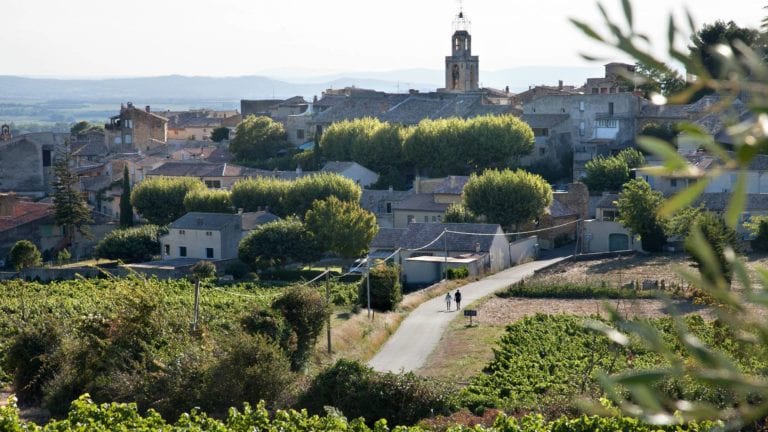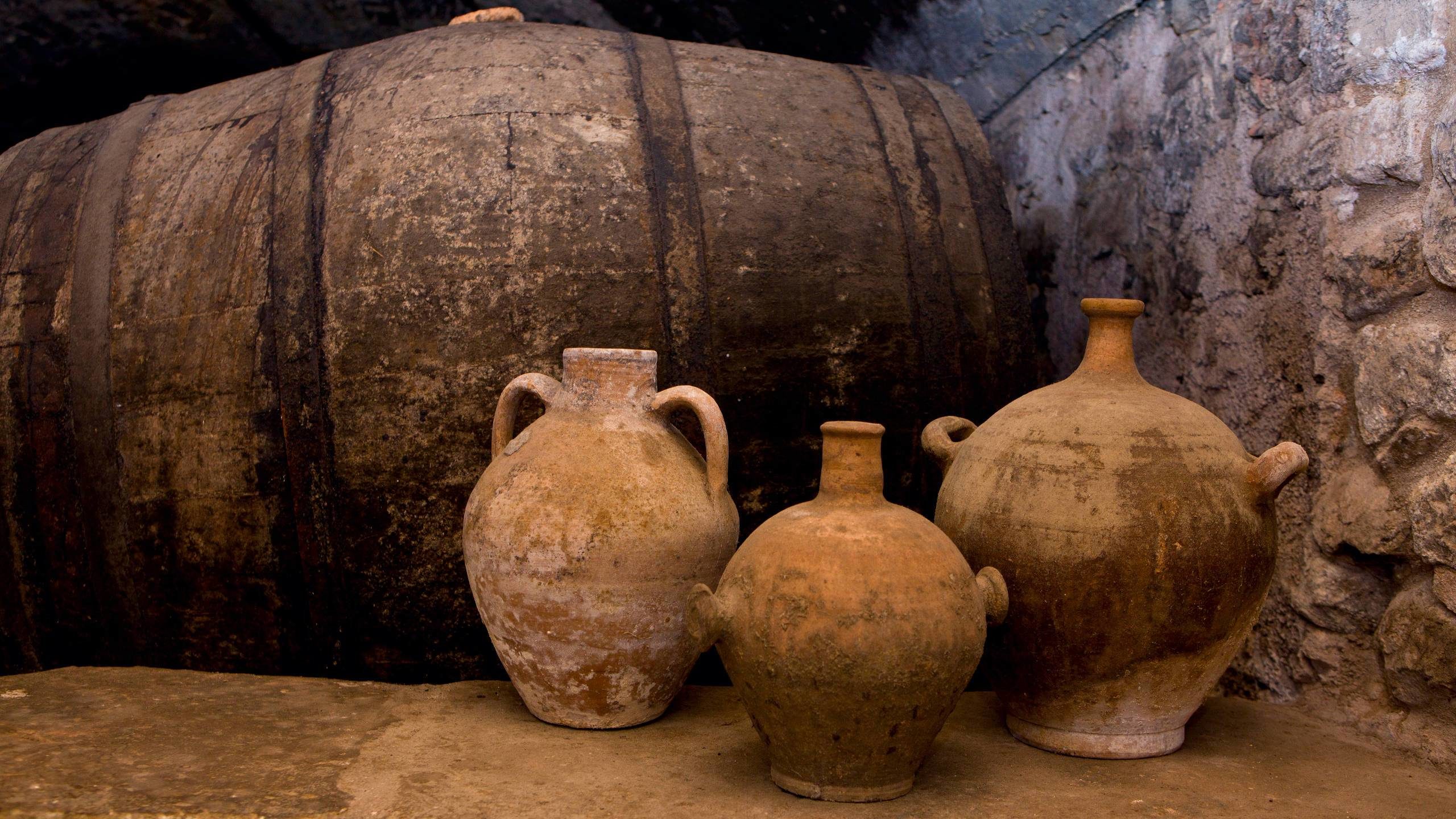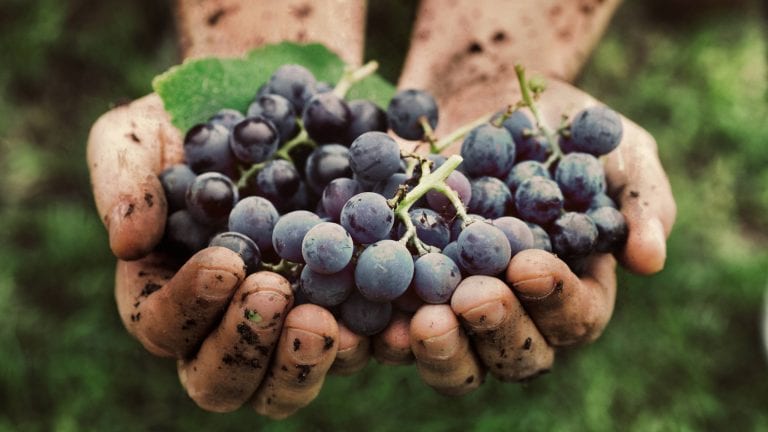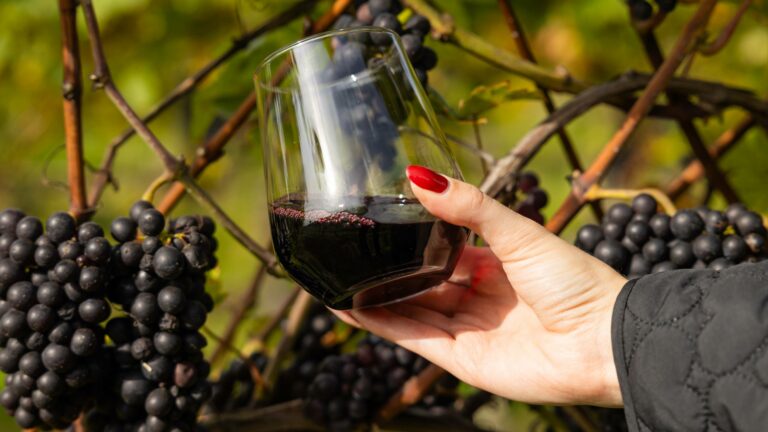

Illustrated History of Wine
Wine has been at the centre of the civilized human world for millennia. In our illustrated guide, we take you on a journey beginning with the origins of winemaking dating all the way back to 7000 BC, right through to the modern day. Learn about the earliest evidence of fermentation, the very first wine labels, the beginnings of the wine trade, regulation and wine’s relationship with religion. Use the timeline navigation below and click your way through the history of wine!
Earliest evidence of intentionally cultivated grapes
First evidence of grapes being grown intentionally and harvested in Georgia.
First evidence of grapes being grown intentionally and harvested in Georgia.
Earliest evidence of wine fermentation
Archaeological evidence of wine fermentation in Georgia, in the form of 8,000 year old grape residue and remains of wines found in ancient clay jars. It’s believed that wine originated in the Caucasus and Zagros Mountains, which span from Armenia through to Georgia, then onto the Middle East, and contain the highest peaks in Europe. Signs of grape domestication were also found in eastern Turkey, just west of the Caucasus Mountains. Fermented fruit residue stored in stoneware jars was also found in the Yellow River Valley of China.
Archaeological evidence of wine fermentation in Georgia, in the form of 8,000 year old grape residue and remains of wines found in ancient clay jars. It’s believed that wine originated in the Caucasus and Zagros Mountains, which span from Armenia through to Georgia, then onto the Middle East, and contain the highest peaks in Europe. Signs of grape domestication were also found in eastern Turkey, just west of the Caucasus Mountains. Fermented fruit residue stored in stoneware jars was also found in the Yellow River Valley of China.
Earliest example of complete wine production
Evidence of the oldest winery in the world discovered in a cave in the village of Areni in the mountains of Armenia. The site contained jars, cups, a wine press and fermentation vats.
Evidence of the oldest winery in the world discovered in a cave in the village of Areni in the mountains of Armenia. The site contained jars, cups, a wine press and fermentation vats.
Wine became symbolic
Grape cultivation introduced to Egypt (most likely through the Levant region connecting Turkey to Egypt), and symbolism and meaning were attached to red wine due to its resemblance to blood. Jars were buried with the early Egyptian King Scorpion I in 3,150 BC, which were found to contain traces of wine. It is thought that Ancient Egyptian kings and queens were buried with precious items and treasures from their life that would act as lucky charms as they entered the afterlife. Wine in Ancient Egypt was predominantly red.
Grape cultivation introduced to Egypt (most likely through the Levant region connecting Turkey to Egypt), and symbolism and meaning were attached to red wine due to its resemblance to blood. Jars were buried with the early Egyptian King Scorpion I in 3,150 BC, which were found to contain traces of wine. It is thought that Ancient Egyptian kings and queens were buried with precious items and treasures from their life that would act as lucky charms as they entered the afterlife. Wine in Ancient Egypt was predominantly red.
Earliest evidence of wine labelling
The Ancient Egyptians started engraving information on their clay wine jars, known as amphora, as they dried. The hieroglyphics stated the year the wine was made, who made it, where it was made, and even details of the wine’s quality.
The Ancient Egyptians started engraving information on their clay wine jars, known as amphora, as they dried. The hieroglyphics stated the year the wine was made, who made it, where it was made, and even details of the wine’s quality.
Wine in Greek mythology
A period in time when the Ancient Greeks worshipped Dionysus, the god of wine, winemaking and grape cultivation. During this time, viticulture spread throughout Greece and wine-producing techniques developed, making wine a major part of Greek culture. Dionysus, therefore, became a popular and significant figure in mythology, and the Ancient Greeks drank to him to banish their worries.
“The people of the Mediterranean began to emerge from barbarism when they learnt to cultivate the olive and the vine.” – Thucydides, Greek historian
A period in time when the Ancient Greeks worshipped Dionysus, the god of wine, winemaking and grape cultivation. During this time, viticulture spread throughout Greece and wine-producing techniques developed, making wine a major part of Greek culture. Dionysus, therefore, became a popular and significant figure in mythology, and the Ancient Greeks drank to him to banish their worries.
“The people of the Mediterranean began to emerge from barbarism when they learnt to cultivate the olive and the vine.” – Thucydides, Greek historian
Wine connected to civilisation
In the Classical period, it became tradition for the Ancient Greeks to end every banquet with a symposium (which means “to drink together”). After their meal, diners would drink wine for pleasure and enjoy an evening of music, dancing and conversation. The Ancient Greeks drank both white and red wine.
In the Classical period, it became tradition for the Ancient Greeks to end every banquet with a symposium (which means “to drink together”). After their meal, diners would drink wine for pleasure and enjoy an evening of music, dancing and conversation. The Ancient Greeks drank both white and red wine.
Origins of wine trading
During the period known as the Hellenistic years, wine production became big in the Aegean Islands. These Greek islands became trade centres for the Mediterranean and the whole of Alexander the Great’s empire, which stretched as far as Asia. This instigated the spread of the wine ‘industry’ to Italy, southern France, Spain and Portugal. The Greeks are generally credited for introducing viticulture to China around this time when a successor of Alexander the Great settled there (although there is evidence that wine fermentation began in China a few thousand years previous to this).
During the period known as the Hellenistic years, wine production became big in the Aegean Islands. These Greek islands became trade centres for the Mediterranean and the whole of Alexander the Great’s empire, which stretched as far as Asia. This instigated the spread of the wine ‘industry’ to Italy, southern France, Spain and Portugal. The Greeks are generally credited for introducing viticulture to China around this time when a successor of Alexander the Great settled there (although there is evidence that wine fermentation began in China a few thousand years previous to this).
Early signs of wine regulation
Roman festivals known as the Bacchanalia were thrown in honour of Bacchus, the Roman god of wine, celebration and fertility (their equivalent to the Greek god Dionysus). In this year, the cult of Bacchus was banned for being too debauched for Rome, and legislation in the form of an inscription brought Bacchanalia under control of the senate.
Roman festivals known as the Bacchanalia were thrown in honour of Bacchus, the Roman god of wine, celebration and fertility (their equivalent to the Greek god Dionysus). In this year, the cult of Bacchus was banned for being too debauched for Rome, and legislation in the form of an inscription brought Bacchanalia under control of the senate.
Wine and Christianity
Wine popularity grew with Christianity, as it became intrinsically linked to religious ceremonies and beliefs about Jesus Christ. Known as sacramental wine, communion wine, or altar wine, red wine was consumed to symbolise the blood of Christ.
Wine popularity grew with Christianity, as it became intrinsically linked to religious ceremonies and beliefs about Jesus Christ. Known as sacramental wine, communion wine, or altar wine, red wine was consumed to symbolise the blood of Christ.
Wine reaches America
First wine to land on American soil when Spanish admiral Pedro Menéndez de Avilés went on an expedition to Florida.
First wine to land on American soil when Spanish admiral Pedro Menéndez de Avilés went on an expedition to Florida.
Wine reaches South Africa
Dutch colonial Jan van Riebeeck arrives in Cape Town and produces first bottle of wine on South African soil.
Dutch colonial Jan van Riebeeck arrives in Cape Town and produces first bottle of wine on South African soil.
Invention of Champagne
The now famous French monk Dom Pérignon was appointed ‘cellar master’ at Hautvillers Abbey to maintain the high quality of the monastery vineyards in the Champagne region. He invented secondary fermentation, which causes bubbles in wine, leading to the creation of champagne as we know it today.
The now famous French monk Dom Pérignon was appointed ‘cellar master’ at Hautvillers Abbey to maintain the high quality of the monastery vineyards in the Champagne region. He invented secondary fermentation, which causes bubbles in wine, leading to the creation of champagne as we know it today.
Glass bottles and labels produced
During this time, wine started being stored in glass bottles for the first time. The design was improved in 1740 to enable bottles to be laid on their side, allowing for wines to be stored and aged over a long period of time. With the invention of the glass wine bottle, the method of identifying what was inside needed to change from inscriptions. Lithography was invented in 1796 by German author Alois Senefelder, paving the way for the first wine label as we know it today to be printed in 1798.
During this time, wine started being stored in glass bottles for the first time. The design was improved in 1740 to enable bottles to be laid on their side, allowing for wines to be stored and aged over a long period of time. With the invention of the glass wine bottle, the method of identifying what was inside needed to change from inscriptions. Lithography was invented in 1796 by German author Alois Senefelder, paving the way for the first wine label as we know it today to be printed in 1798.
Wine reaches Australia
Royal Navy admiral Arthur Phillip lands in Australia, bringing vine cuttings with him, which sparked other settlers to cultivate the land for winemaking.
Royal Navy admiral Arthur Phillip lands in Australia, bringing vine cuttings with him, which sparked other settlers to cultivate the land for winemaking.
Wine appellation introduced in France
Laws passed in France to control who is entitled to use region and location names on their wine bottles. The Appellation d’origine contrôlée system was established to define and protect geographical indication found on a wine label, to ensure the quality of wine produced in France was maintained. Appellations were later introduced in Italy and Spain.
Laws passed in France to control who is entitled to use region and location names on their wine bottles. The Appellation d’origine contrôlée system was established to define and protect geographical indication found on a wine label, to ensure the quality of wine produced in France was maintained. Appellations were later introduced in Italy and Spain.
Advanced vineyards
Advancements in technology and science enable winegrowers to start using tractors for tending vines and sprays for effective disease control.
Advancements in technology and science enable winegrowers to start using tractors for tending vines and sprays for effective disease control.


